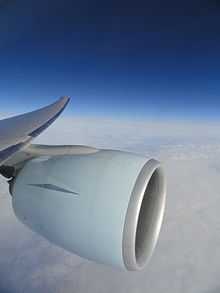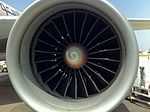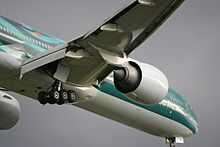General Electric GE90
| GE90 | |
|---|---|
 | |
| GE90-115B | |
| Type | Turbofan |
| Manufacturer | GE Aviation |
| First run | September 23, 1994 |
| Major applications | Boeing 777 |
| Developed into | General Electric GEnx Engine Alliance GP7000 |
The General Electric GE90 is a family of high-bypass turbofan aircraft engines built by GE Aviation for the Boeing 777, with thrust ratings ranging from 74,000 to 115,000 lbf (330 to 510 kN). It entered service in November 1995. Currently the world’s largest turbofan engine, it is one of three options for the 777-200, -200ER, and -300, and the exclusive engine of the -200LR, -300ER, and 777F.
Design and development

The GE90 was launched in 1990.[1] GE Aviation is associated with Snecma (France), IHI (Japan) and Avio (Italy). Developed from the 1970s NASA Energy Efficient Engine, the 10-stage high pressure compressor develops a pressure ratio of 23:1 (an industry record) and is driven by a 2-stage, air-cooled, HP turbine. A 3-stage intermediate pressure compressor, situated directly behind the fan, supercharges the core. The fan/IPC is driven by a 6-stage low pressure turbine.

The higher-thrust variants, GE90-110B1 and -115B, have a different architecture from the earlier marks of GE90, with one stage removed from the HP compressor (probably from the rear, to increase core size), with an extra stage added to the IP compressor to maintain/increase overall pressure ratio to achieve a net increase in core flow. General Electric performed a similar re-staging exercise when they upgraded the CF6 from the -6 to the higher thrust -50. However, this thrust growth route is expensive, since all the downstream components (e.g. turbines) must be larger (in flow capacity). As a result GE sought (and received) sole engine supplier status with the -115B on the Boeing 777-300ER. The fan is an advanced, larger diameter unit made from composite materials and is the first production engine to feature swept rotor blades. Although the larger fan in itself would produce a higher static thrust, an increase in core size and, thereby core power, was required to improve the net thrust at normal flight speeds.
The GE90-115B is powerful enough to fully operate GE's Boeing 747 testbed on its own power demonstrated during a flight test.[2][3]
Operational history

The first General Electric-powered Boeing 777 was delivered to British Airways on November 12, 1995;[4] the aircraft, with two GE90-77Bs, entered service five days later.[5] Initial service was affected by gearbox bearing wear issues, which caused the airline to temporarily withdraw its 777 fleet from transatlantic service in 1997.[5] British Airways' aircraft returned to full service later that year,[6] and General Electric subsequently announced engine upgrades.
Due to the expense of producing the higher-thrust GE-90 variants, the GE90-115B is the sole engine available on the Boeing 777-300ER. The ultra-long range Boeing 777-200LR is normally fitted with the GE90-110B1 but can also take the -115B. The GE90-equipped Boeing 777s have been the best-selling long-range large wide-body aircraft in the 2000s at the expense of the Airbus A340.[7] The -94B for the -200LR is being retrofitted[8] with some of the first FAA-approved 3D-printed components.[9]
The GE90 series are physically the largest engines in aviation history, the fan diameter of the original series being 312 cm (123 in). The largest variant, the GE90-115B, has a fan diameter of 325 cm (128 in). As a result, GE90 engines can only be airfreighted in assembled form by outsize cargo aircraft such as the Antonov An-124 Condor, presenting unique problems if, due to emergency diversions, a 777 were stranded in a place without the proper spare parts. If the fan is removed from the core, then the engines may be shipped on a 747 Freighter.[10]
Records
In October 2003, a Boeing 777-300ER broke the ETOPS record by being able to fly five and a half hours (330 minutes) with one engine shut down.[11] The aircraft, with GE90-115B engines, flew from Seattle to Taiwan as part of the ETOPS certification programme.
According to the Guinness Book of Records, at 127,900 pounds-force (569 kN), the engine holds the record for the highest thrust (although rated at 115,300 pounds-force (513 kN)). This thrust record was accomplished inadvertently as part of a one-hour, triple-red-line engine stress test. In order to accommodate the increase in torsional stresses an entirely new steel alloy (GE1014) had to be created and then machined to extreme tolerances.[12] The new record was set during testing of a GE90-115B development engine at GE Aviations' Peebles Test Operation, which is an outdoor test complex outside Peebles, Ohio. It eclipsed the engine's previous Guinness world record of 122,965 pounds-force (546.98 kN).[13]
On November 10, 2005, the GE90 entered the Guinness World Records for a second time. The GE90-110B1 powered a 777-200LR during the world's longest flight by a commercial airliner, though there were no fare-paying passengers on the flight, only journalists and invited guests. The 777-200LR flew 13,422 miles (21,601 km) in 22 hours, 42 minutes, flying from Hong Kong to London "the long way": over the Pacific, over the continental U.S., then over the Atlantic to London.[14]
Airworthiness Directive
The FAA issued an Airworthiness Directive on May 16, 2013 and sent it to owners and operators of General Electric Company (GE) GE90-110B1 and GE90-115B turbofan engines. This emergency AD was prompted by reports of two failures of transfer gearbox assemblies (TGBs) which resulted in in-flight shutdowns (IFSDs). Investigation has revealed that the failures were caused by TGB radial gear cracking and separation. Further inspections found two additional radial gears with cracks. This condition, if not corrected, could result in additional IFSDs of one or more engines, loss of thrust control, and damage to the airplane. The Airworthiness Directive requires compliance by taking remedial measures within 5 days of receipt of the AD.[15]
Variants

- GE90-76B
- Rated at 76,000 pounds-force (340 kN)
- GE90-77B
- Rated at 77,000 pounds-force (340 kN)
- GE90-85B
- Rated at 85,000 pounds-force (380 kN)
- GE90-90B
- Rated at 90,000 pounds-force (400 kN)
- GE90-92B
- Rated at 92,000 pounds-force (410 kN)
- GE90-94B
- Rated at 93,000 pounds-force (410 kN)
- GE90-110B1
- Rated at 110,100 pounds-force (490 kN)
- GE90-115B
- Rated at 115,300 pounds-force (513 kN)
Specifications
GE90-94B
General characteristics
- Type: axial flow, twin-shaft, bypass turbofan engine
- Length: 287 in (7,290 mm)[16]
- Diameter: overall: 134 in (3,404 mm);[16] fan: 123 in (3,124 mm)
- Dry weight: 16,644 lb[16] (7,550 kg)
Components
- Compressor: axial: 1 wide chord fan, 3 low pressure stages, 10 high pressure stages
- Turbine: axial: 6 low pressure stages, 2 high pressure stages
Performance
- Maximum thrust: max at sea level: 93,700 lbf (416.8 kN)
- Overall pressure ratio: 42:1
- Thrust-to-weight ratio: approx. 5.6:1
GE90-115B

General characteristics
- Type: axial flow, twin-shaft, bypass turbofan engine
- Length: 287 in (7,290 mm)[17]
- Diameter: overall: 135 in (3.429 m);[17] fan: 128 in (3.251 m)
- Dry weight: 18,260 lb (8,283 kg)[17]
Components
- Compressor: axial: 1 wide chord swept fan, 4 low pressure stages, 9 high pressure stages
- Turbine: axial: 6 low pressure stages, 2 high pressure stages
Performance
- Maximum thrust: max at sea level: 115,300 lbf (514 kN) ; world record set at 127,900 lbf (568,9 kN) in testing 827 feet above sea level[8]
- Overall pressure ratio: 42:1
- Thrust-to-weight ratio: approx. 6.3:1
Derivatives
GEnx
The GEnx engine, that has been developed for the Boeing 787 Dreamliner and 747-8, is derived from a smaller core variant of the GE90, but features a fan with swept rotor blades. GE Aviation has also set up a cooperative venture with Pratt & Whitney, named Engine Alliance, under which the companies have developed an engine for the Airbus A380, called the GP7000, from the larger GE90-110B/115B core.
GE9X
In February 2012 GE announced studies on a slightly smaller derivative engine, dubbed the GE9X, to power the new Boeing 777-8x/9x aircraft. It was to feature the same fan diameter as the GE90-115B (128 in (326 cm)) with an overall thrust decrease of 15,800 lbf to a new rating of 99,500 lbf per engine for the -9X, and a derated 88,000 lbf version for the -8X. The new engines are expected to contribute to a 10% increase in fuel efficiency with a planned 10:1 bypass ratio, 60:1 overall pressure ratio and 27:1 high pressure compressor ratio.[18][19][20]
GE recently updated the GE9X specifications to reflect growing concerns that the 777X was under-powered. Design changes include a slight increase of thrust to 105,000 lbf and a new fan diameter of 133.5 in, giving the new engine the largest fan GE has ever produced.[21][22][23][24]
See also
- Related development
- Comparable engines
- Related lists
Footnotes
References
- ↑ "First Year in Service for GE90 a Huge Success". geaviation.com. 1996-11-18. Retrieved 2014-11-26.
- ↑ "GE90-115B certification: a look at the flight tests". Le Webmag. August 8, 2003. Retrieved January 22, 2011.
- ↑ General Electric Biggest Jet Engine for B-777. History Channel. c. 2008. Event occurs at 3:00–3:10 min. Retrieved August 21, 2014.
- ↑ Eden 2004, p. 115
- ↑ 5.0 5.1 Norris & Wagner 1999, p. 143
- ↑ Norris & Wagner 1999, p. 144
- ↑ Flottau, Jens. "Airbus Bids Adieu to A340, Postpones A350 Delivery." Aviation Week & Space Technology, 14 November 2011.
- ↑ 8.0 8.1 Dalløkken, Per Erlien (21 April 2015). "Verdens største jetmotor får 3D-printet komponent" [World's biggest jet engine gets 3D-printed component]. Teknisk Ukeblad. Retrieved 22 April 2015.
- ↑ GE
- ↑ "GE strives to identify Air France engine fault". Flight International. 2006-01-03. Retrieved 2008-02-16.
- ↑ "Boeing 777-300ER Performs 330-Minute ETOPS Flight" (Press release). Boeing. October 15, 2003. Retrieved January 21, 2011.
- ↑ "Impressive Progress of GE90-115B Engine Continues". July 24, 2000. Retrieved 18 December 2008.
- ↑ "GE90 Sets New World Record For Thrust; Engine Completes FAR 33 Certification Tests". February 5, 2003. Retrieved 14 April 2011.
- ↑ "The longest flight". Seattle Post-Intelligencer. Retrieved 2008-02-16.
- ↑ "Emergency airworthiness directive (AD) 2013-10-52 is sent to owners and operators of General Electric Company (GE) GE90-110B1 and GE90-115B turbofan engines." (PDF). May 16, 2013. Retrieved 16 May 2013.
- ↑ 16.0 16.1 16.2 "Model GE90-94B". GE Aviation. Retrieved January 22, 2011.
- ↑ 17.0 17.1 17.2 "Model GE90-115B". GE Aviation. Retrieved January 21, 2011.
- ↑ Ostrower, Jon. "Next generation 777 comes into focus". Flight Global. Reed Business Information. Retrieved 2011-09-27.
- ↑ Nguyen, Hoang (September 14, 2012). "Boeing's 777-9X comes into focus with a massive CFRP wing". Flight Global. Reed Business Information. Retrieved 2011-09-27.
- ↑ GE plans 10% fuel burn improvement for GE9X engine. Flightglobal.com (2012-03-07). Retrieved on 2013-08-16.
- ↑ GE9X. GE Aviation. Retrieved on 2013-08-16.
- ↑ The New GE9X Engine - GE Aviation. YouTube (2013-06-17). Retrieved on 2013-08-16.
- ↑ GE Pushes Envelope With GE9X for New Boeing 777 | Aviation International News. Ainonline.com (2013-06-16). Retrieved on 2013-08-16.
- ↑ Aviation Week. Aviationweek.com (2014-06-09). Retrieved on 2014-06-10.
Bibliography
- Eden, Paul, ed. (2008). Civil Aircraft Today: The World's Most Successful Commercial Aircraft. London: Amber Books Ltd. ISBN 1-84509-324-0.
- Norris, Guy; Mark Wagner (1999). Modern Boeing Jetliners. Minneapolis, Minnesota: Zenith Imprint. ISBN 0-7603-0717-2.
External links
| Wikimedia Commons has media related to General Electric GE90. |
- GE90 page on geae.com
- It's Great Design Too: World's Biggest Jet Engine Fan Blade at The Museum of Modern Art.
| ||||||||||||||||||||||
| ||||||||||||||||||||||